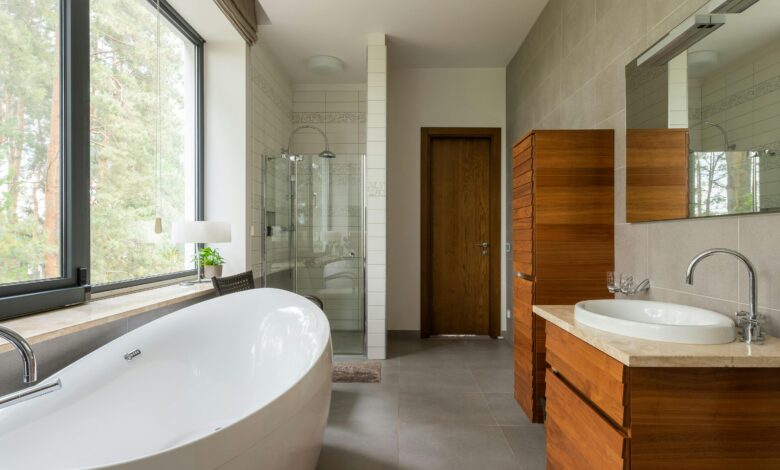The Best Tips for Bathroom Renovations: A Comprehensive Guide

Bathroom renovations can be one of the most rewarding home improvement projects, offering both functional and aesthetic benefits. Whether you’re updating a small powder room or completely overhauling a master bath, careful planning and execution are key to achieving a successful outcome. This guide provides expert tips to help you navigate the process, avoid common pitfalls, and create a bathroom that meets your needs and enhances your home’s value.
1. Plan Your Renovation Carefully
1.1. Set a Realistic Budget
- Determine how much you’re willing to spend, including a contingency fund (typically 10-20% of the total budget) for unexpected expenses.
- Prioritize essential upgrades like plumbing, fixtures, and waterproofing over cosmetic changes if your budget is tight.
1.2. Define Your Goals
- Identify the purpose of the renovation: Are you improving functionality, increasing resale value, or creating a spa-like retreat?
- Consider who will use the space—children, elderly family members, or guests—and tailor the design accordingly.
1.3. Research Trends and Styles
- Explore current bathroom trends, such as minimalist designs, natural materials, or bold tile patterns, but ensure they align with your personal taste and home’s overall style.
- Create a mood board or Pinterest collection to visualize your ideas.
2. Hire the Right Professionals
2.1. Choose Licensed Contractors
- Hire licensed plumbers, electricians, and contractors with experience in bathroom renovations.
- Check references, read reviews, and ask for examples of past work to ensure quality craftsmanship.
2.2. Work with a Designer (Optional)
- If you’re unsure about layout or design, consider hiring an interior designer or architect to maximize space and functionality.
2.3. Get Multiple Quotes
- Obtain at least three quotes from different contractors to compare pricing and services.
- Be wary of estimates that seem too low—they may indicate hidden costs or subpar workmanship.
3. Optimize Layout and Space
3.1. Maximize Small Spaces
- Use wall-mounted vanities, corner sinks, or floating shelves to free up floor space.
- Install large mirrors to create the illusion of a bigger room.
3.2. Improve Flow and Accessibility
- Ensure there’s enough clearance around fixtures (e.g., toilets, showers) for comfortable movement.
- Incorporate universal design principles, such as grab bars and curbless showers, to make the space accessible for all ages and abilities.
3.3. Consider Storage Solutions
- Add built-in cabinets, recessed shelving, or linen closets to keep clutter at bay.
- Opt for multi-functional furniture, like mirrored medicine cabinets or vanity drawers with organizers.
4. Focus on Key Elements
4.1. Plumbing and Fixtures
- Upgrade old pipes and fixtures to prevent leaks and improve water efficiency.
- Invest in high-quality faucets, showerheads, and toilets that combine durability with style.
4.2. Lighting
- Layer lighting with a mix of ambient, task, and accent options:
- Recessed ceiling lights for general illumination.
- Vanity lighting above or beside mirrors to reduce shadows.
- Dimmer switches for adjustable brightness.
4.3. Tile and Flooring
- Choose slip-resistant tiles for safety, especially in wet areas like showers and tub surrounds.
- Use durable, moisture-resistant materials like porcelain or ceramic for floors and walls.
4.4. Ventilation
- Install a properly sized exhaust fan to prevent mold and mildew caused by excess humidity.
- Ensure the fan vents directly outside, not into attics or crawl spaces.
5. Prioritize Quality Materials and Finishes
5.1. Countertops
- Select durable materials like quartz, granite, or solid surface countertops that resist stains and scratches.
- Match the countertop material to the overall style of the bathroom.
5.2. Shower and Tub
- Frameless glass shower doors add a sleek, modern touch.
- Freestanding tubs are ideal for creating a luxurious focal point in larger bathrooms.
5.3. Hardware and Accessories
- Coordinate finishes (e.g., brushed nickel, matte black) across faucets, towel bars, and cabinet pulls for a cohesive look.
- Choose rust-resistant hardware to withstand humid environments.
6. Avoid Common Mistakes
6.1. Underestimating Plumbing Costs
- Relocating plumbing lines can significantly increase expenses; plan carefully to minimize changes.
6.2. Skipping Waterproofing
- Ensure proper sealing around showers, tubs, and sinks to prevent water damage and costly repairs.
6.3. Overlooking Lighting Needs
- Poorly lit bathrooms can feel unwelcoming and impractical. Plan for adequate lighting during the design phase.
6.4. Choosing Trendy Over Timeless
- While trendy designs may look appealing now, timeless elements ensure longevity and broader appeal when selling your home.
7. Incorporate Smart Technology
7.1. Smart Mirrors
- Mirrors with integrated LED lighting, defoggers, or Bluetooth speakers enhance convenience and luxury.
7.2. Voice-Controlled Devices
- Install smart speakers or voice-controlled lighting systems for hands-free operation.
7.3. Energy-Efficient Fixtures
- Low-flow toilets, water-saving showerheads, and motion-sensor faucets reduce utility bills and environmental impact.
8. Add Personal Touches
8.1. Color Palette
- Neutral tones like whites, grays, and beiges create a calming atmosphere, while pops of color (e.g., navy blue, emerald green) add personality.
8.2. Decorative Accents
- Incorporate plants, artwork, or decorative tiles to infuse character into the space.
8.3. Luxury Features
- Consider heated floors, rainfall showerheads, or soaking tubs for added comfort and indulgence.
9. Prepare for Post-Renovation Maintenance
9.1. Clean Grout Regularly
- Prevent mold and discoloration by cleaning grout lines with a mild cleaner every few months.
9.2. Inspect Seals and Caulking
- Check seals around sinks, tubs, and showers annually to maintain waterproofing.
9.3. Update Hardware Periodically
- Refresh the look of your bathroom by swapping out outdated hardware or accessories.



